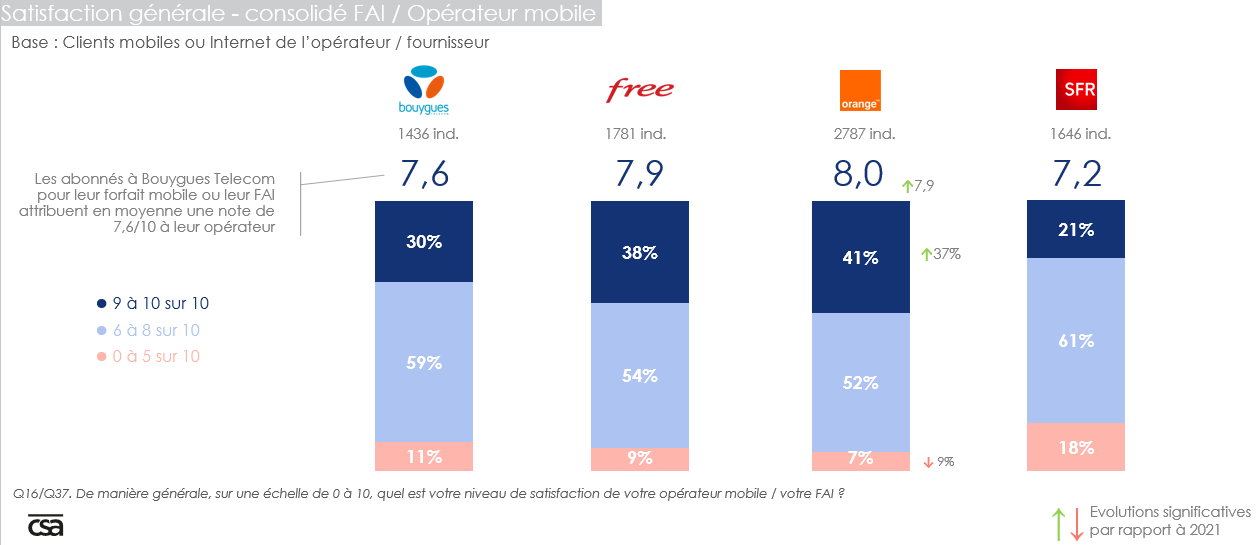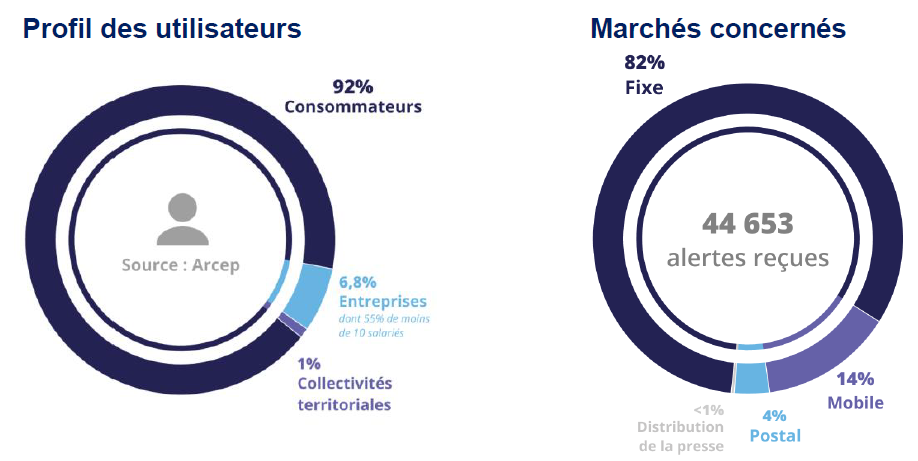Users’ satisfaction with the sectors regulated by Arcep is one of the guiding forces behind the actions taken by the Authority. Arcep has been assessing these satisfaction levels for several years, along with the main sources of user dissatisfaction and the actions being taken as a result by presenting:
- The findings of its annual observatory of customer satisfaction with internet service providers and mobile operators;
- And the main takeaways from the reports received via the “J’alerte l’Arcep” site over the course of 2022.
Customer satisfaction observatory: once again this year, network quality of service – and fixed network QoS in particular – remains the number one issue for users
The 2023 edition of the “Customer satisfaction observatory” is based on a survey conducted by CSA in late 2022. Fixed and/or mobile network subscribers’ overall satisfaction is slightly higher than the year before (+ 0.1 point YoY). Users’ satisfaction with their mobile operator (scoring 7.8/10 on average compared to an average 7.7/10 in 2021) remains higher overall than their satisfaction with their internet service providers (ISP): with an average score of 7.6/10 compared to 7.5/10 on average in 2021.
Once again this year, the main issues encountered involved quality of service, and fixed network QoS in particular. Fifty six percent of users (48% when excluding “spam/unwanted telemarketing calls” which overall cannot be attributed to operators) reported encountering a problem with their ISP.
“J’alerte l’Arcep”: increase in the number of reports received compared to the previous year. Quality of service, especially on fixed networks, is still the main source of users’ dissatisfaction.
Laure de La Raudière reiterated the benefits of the “J’alerte l’Arcep” platform as a regulatory tool: “J’alerte l’Arcep provides a very concrete way to take the market’s temperature. Arcep teams can “live stream” user reports, and so obtain an immediate snapshot of problems being encountered in the field. It is a tremendous tool for the regulator, and invaluable for informing our interactions with operators, in bringing them to fix the problems that arise”.
Since its launch in 2017, the “J’alerte l’Arcep” platform has allowed users to submit close to 200,000 reports. In 2022, Arcep received more than 44,600 reports, including some 36,000 directly on the platform – the remaining alerts being received through other channels (email, the post, phone calls). This marks a sizeable increase (+17% YoY) over 2021 during which 38,000 reports were received from users.
The vast majority of the reports received concern the telecoms sector. Within this sector, it is fixed internet services that were the subject of most reports (36,724 reports received in 2022, or more than 82% of the total number of reports). Among them, by far the most prevalent source of dissatisfaction was fibre network rollouts. Mobile networks received a comparatively smaller number of complaints than in 2021, decreasing to 6,167 in 2022.
The main sources of dissatisfaction expressed on “J’alerte l’Arcep” were confirmed by the customer satisfaction observatory that was produced based on a survey conducted by the CSA institute.
“J’alerte l’Arcep”: when publishing its annual scorecard, Arcep delivered a reminder of the benefits of its reporting platform and data-driven regulation tool, and highlighted five types of recurring report:
Since its launch in 2017, the “J’alerte l’Arcep” reporting platform has given individuals, businesses and local authorities the ability to report any malfunctions encountered in their relationship with their fixed or mobile operator, internet service provider, and postal service or press distribution providers. It provides users with the opportunity to have their own experience inform market regulation, through citizen action, and give operators an incentive to improve their services and develop their networks. Users are also offered tip sheets tailored to their situations at the end of the reporting process. The received reports give Arcep the ability to track the problems being encountered by users in real time, to identify recurrent malfunctions, and detect spikes in user alerts. This serves the Authority’s ultimate aim of taking more targeted, and thereby more effective, regulatory action with operators.
Five types of report caught the regulator’s attention this past year:
1. Fibre network quality of service
The number of reports from users about having their fibre line cut off doubled this year, and accounted for around 10% of all reports regarding fibre access. Aware of this issue for several years now, Arcep has made fibre network QoS a top priority. The reports therefore help guide the work that operators have been doing – under Arcep’s aegis – to identify and repair the shared access points that require it. This work is ongoing, in accordance with Arcep’s supplementary action plan for improving the quality of FttH operations published in in November 2021, and with the commitments the sector made in September 2021. In addition, certain networks are the target of Altitude Infrastructure, XPFibre and Free OI refurbishment schemes.
2. Copper network quality of service
Around 3,000 users altered Arcep to quality of service issues with their ADSL access, which accounted for more than 80% of reports regarding copper access technology. Arcep reiterated that Orange must maintain the quality of its legacy copper network right up to switch-off, and requires Orange to publish quality of service indicators to this end. The Authority monitors these indicators as part of the process of ensuring compliance with some of the indicators’ thresholds.
3. Anomalies regarding European and international roaming
Arcep received reports pertaining to mobile network access while roaming in Europe and around the globe. Reports detailed, for instance, the lack of a “welcome” text from an operator when roaming in Switzerland, or the handover from a mobile to a satellite network during certain maritime crossings, without being informed of it. This results in overage billing, even though the user is still on French territory. These reports enabled Arcep to contact the operators involved, so that they might resolve the issue.
4. Quality and accessibility of Voice over Wi-Fi services
Consumers reported problems using “Voice over Wi-Fi”, and especially the disappointing quality of service and incompatibility with their mobile phones. These reports gave Arcep the ability to initiate a dialogue on the topic with operators, to understand the problems encountered by users and so to fix them.
5. Undistributed mail
Users reported to Arcep that some of their mail was being returned to sender before being distributed as they were considered, erroneously, as not living at the stated address. Arcep became aware of this issue thanks to these reports. It contacted La Poste to understand the reason for the mistakes. La Poste took steps to resolve these malfunctions.


